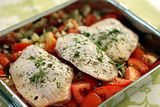
Audax Artifex was our January 2012 Daring Bakers’ host. Audax worked tirelessly to master light and fluffy scones (a/k/a biscuits) to help us create delicious and perfect batches in our own kitchens!
These are my currant scones. I am quite pleased with them - they certainly taste good, but I think there is room for improvement still (perhaps a teeny bit higher). I would like to thank Audax for his excellent challenge choice and articles on "Sconery" - for the first time I triple-sifted the flour and it paid off. I have never made nice scones before this. I also went for the flaky scones, with larger bits of butter, and refrigerated the flour and dough between actual bench work times. I also chose the "by hand" option - so easy and restful, real comfort baking. I am taking them to the office tomorrow and cannot wait to see what the team has to say about them - it's something different as mostly they get cookies.
The next day: I think these have been the most popular desserts that I have taken to work yet! There was a VIP meeting in the boss's office so I put half of the scones on a plate for the meeting; the other half was for the rest of us; also provided salted butter and raspberry jam for those who did not want the scones plain. Talking about popularity, the group was even talking about them the following day.
Thank you, Audax! I can see that I will never be at a loss for what to make and am now browsing through a lot of U.K. scones recipes to get different kinds of flavors.
Recipe for Currant Scones (From Epicurious from Sarabeth's Bakery)
Ingredients
3/4 cup whole milk
2 large eggs, chilled
3 cups unbleached all-purpose flour, plus more as needed
1 tablespoon plus 1 teaspoon baking powder
2 tablespoons superfine sugar
1/4 teaspoon fine sea salt
A few gratings of fresh nutmeg
10 tablespoons (1 1/4 sticks) unsalted butter, chilled and cut into 1/2-inch cubes
1/2 cup dried currants
1 large egg, well beaten with a hand blender, for glazing
print a shopping list for this recipe
Preparation
1. Position a rack in the center of the oven and preheat to 425°F. Line a half-sheet pan with parchment paper.
2. TO MAKE THE DOUGH BY HAND: Whisk the milk and 2 eggs together in a small bowl; set aside. Sift the flour, baking powder, sugar, salt, and nutmeg into a medium bowl. Add the butter and mix quickly to coat the butter with the flour mixture. Using a pastry blender, cut the butter into the flour, scraping the butter off the blender as needed, until the mixture resembles coarse bread crumbs with some pea-size pieces of butter. Mix in the currants. Using a wooden spoon, stir in the milk mixture and mix just until the dough clumps together. TO USE A MIXER: Whisk the milk and 2 eggs together in a small bowl; set aside. Sift the dry ingredients together into the bowl of a heavy-duty stand mixer. Add the butter. Attach the bowl to the mixer and fit with the paddle attachment. Mix on medium-low speed until the mixture looks mealy with some pea-size bits of butter. Mix in the currants. Reduce the mixer speed to low. Add the milk mixture, mixing just until the dough barely comes together.
3. Turn the dough out onto a well-floured work surface and sprinkle about 2 tablespoons of flour on top. Knead the dough a few times, just until it doesn't stick to the work surface. Do not overwork the dough. The surface will be floured, but the inside of the dough should remain on the wet side. Gently roll out the dough into a 3/4-inch-thick round.
4. Using a 2 1/2-inch fluted biscuit cutter, dipping the cutter into flour between cuts, cut out the scones (cut straight down and do not twist the cutter) and place 1 1/2 inches apart on the prepared half-sheet pan. To get the most biscuits out of the dough, cut out the scones close together in concentric circles. Gather up the dough scraps, knead very lightly, and repeat to cut out more scones. You should get two scones from the second batch of scraps. Brush the tops of the scones lightly with the beaten egg, being sure not to let the egg drip down the sides (which would inhibit a good rise).
5. Place the scones in the oven and immediately reduce the heat to 400°F. Bake until golden brown, about 20 minutes. Cool on the pan for a few minutes, then serve warm or cool completely.
























